It was nearly midnight when my plane landed in the middle of the Pacific Ocean on Rapa Nui (Easter Island). The sky was full of stars but sleep would have to wait. I’d come all this way to see the megalithic religious statues that give this speck of an island an outsized reputation around the world. So, less than an hour after I landed I found myself rambling through a row of palms along the northern coast, lured by the sound of lapping waves to the island’s one true beach at Anakena.
The statues were like seven shadow puppets standing watch over the sands of time. Inching across the beach, I found myself face to (giant) face with the enigmatic moai.
Many travellers who set out to visit Easter Island quickly realise that the trip can be expensive. That’s why I had a plan, to explore it over five days in the most affordable way possible: camping, cooking for myself and walking or cycling around. Of course, flying to Mataveri international airport – the most remote airport in the world – isn’t cheap. Neither is the £36 national park entrance fee, which allows you to roam freely on the island. On the plus side, the five-hour flight from Santiago is considered a domestic trip (Easter Island is a Chilean territory), so I arrived with a backpack full of wine and groceries bought on the mainland where prices are more than 50% cheaper.

My aim was to spend the first three nights next to these towering moai on the remote northern coast of the island at Camping Ana Tekena (£19 a night, including all camping equipment). This tranquil, eco-friendly campsite opened in 2016 and is the only place to sleep next to Anakena beach. With hot showers, wood-fired stoves and hammocks big enough to accommodate a football team, it’s a popular choice for budget-conscious Chilean families.
I rented a pitch from owner Kihi Tuki Hito, who told me on the way from the airport that he had recently reclaimed his ancestral land from the Chilean government and opened these fields as a campsite to allow visitors appreciate the island beyond Hanga Roa, the only town, where nearly all other accommodation is located.
The next morning I got my first proper glimpse of the moai that line the edge of Anakena beach. These statues are among 887 created on the island between the 11th and 14th centuries and range in height from 1m to 21m – serving as a remarkable testament to the industrious society that thrived here. Flanked by three extinct volcanoes, Easter Island is 2,075km from the closest landmass (Pitcairn Island) and often has the smell of freshly cut grass with its green pastures and wildflowers, as well as its rocky shores. There is nothing on the horizon, just an empty palette of blue curving into oblivion.

My first full day was spent walking along the rugged and windswept Northern Coast Trail, which is signposted (sparingly) around the tallest volcano, Terevaka. This (moderately challenging) 18km trek began at Anakena beach before passing clifftop rocks covered in ancient petroglyphs. It skirted past former cave dwellings en route to the ceremonial complex of Tahai, whose towering moai welcomed me to Hanga Roa. Once in town, I ate a giant tuna and cheese turnover at Empanadas Tía Berta (£4), rented a mountain bike from Insular Rentals (£14 a day) and pedalled the road through the interior back to Anakena.
After a sunrise dip the next morning at Ovahe beach, about 10 minutes from Anakena, I hopped on my bike and rode past the barren slopes of Poike volcano over to the Rano Raraku volcanic crater. This quarry was the source of an estimated 95% of all known sculptures on the island, and its outer slopes are littered with about 400 moai in various states of disrepair (the reason remains a mystery). Other incomplete statues can be seen, carved out of the crater wall, including one that’s more than 21m high and twice the size of any other moai. Rano Raraku is, perhaps, the best place on the island to appreciate the stupendous rise and dramatic downfall of the Rapa Nui civilisation.
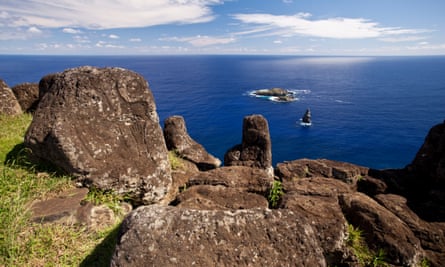
Some historians believe that the building of these monuments depleted the island of many of its trees, which were likely needed to transport the moai. They suggest that without protection from the winds, the soil dried up and crops struggled to survive. A depletion of resources led to intertribal conflict and cannibalism. The population fell from about 15,000 to 2,000, and there was not a moai left standing on the ceremonial stone platforms (called ahu) by the start of the 19th century (those standing today are the work of restoration teams).
I cycled along the southern coast back to Hanga Roa in search of information about the civil war period (late 1700s to mid-1800s) and the cult of the birdman, which was the island religion between the moai era and modern Christian times. I rented a tent at the oceanfront Camping Mihinoa (£12 a night), which is on a peninsula on the south-western coast near Hanga Roa. I then booked a boat tour with dive company Mike Rapu (£24) around the edge of Rano Kau volcano to Moto Nui islet. This tiny island, less than 1km off the southern coast, played host to an annual birdman competition from the early 1700s through the 1860s, where the first man to collect an egg from the migratory sooty tern and bring it back to the ceremonial village of Orongo (atop Rano Kau) would gain supremacy for the coming year.
My visit to Moto Nui wasn’t to gain any superhuman powers, but to snorkel in its indigo waters, which are said to be some of the clearest in the world. Though there is little coral, the perspective of Easter Island’s soaring volcanic cliffs from these crystalline waters was humbling.

On my final day, I visited the Father Sebastian Englert Anthropological Museum. The Rapa Nui people were one of the only civilisations on Earth to independently form their own written language, and this free museum on Hanga Roa’s northern edge has three wooden tablets depicting the so-called rongorongo glyphs.
Despite hardships, Rapa Nui culture is alive and thriving. For proof, look no further than the invigorating song-and-dance shows of the Varua Ora troupe (£18 for a 1.5-hour show) who perform in Restaurant Kanahau in Hanga Roa. The shows feature traditional Hoko warrior dances alongside more recent ukulele anthems. Show director Nancy Manutomatoma, the island’s first female choreographer, told me dance is a way for Rapa Nui people to express repressed ideas and emotions. “There was a long time during the colonial period when our dances and songs weren’t allowed on the island, so we are working hard to revive these traditions.”
This tiny island may have had a dark past, but from Manutomatoma’s viewpoint the future looks brighter every day.
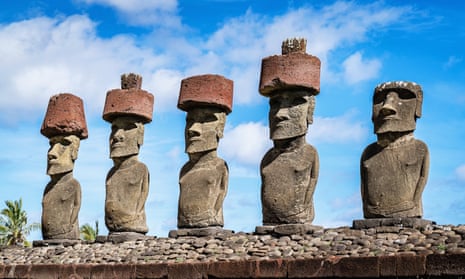

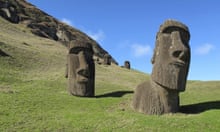
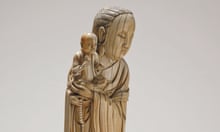


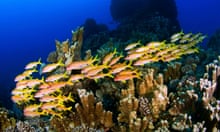
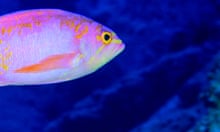

Comments (…)
Sign in or create your Guardian account to join the discussion